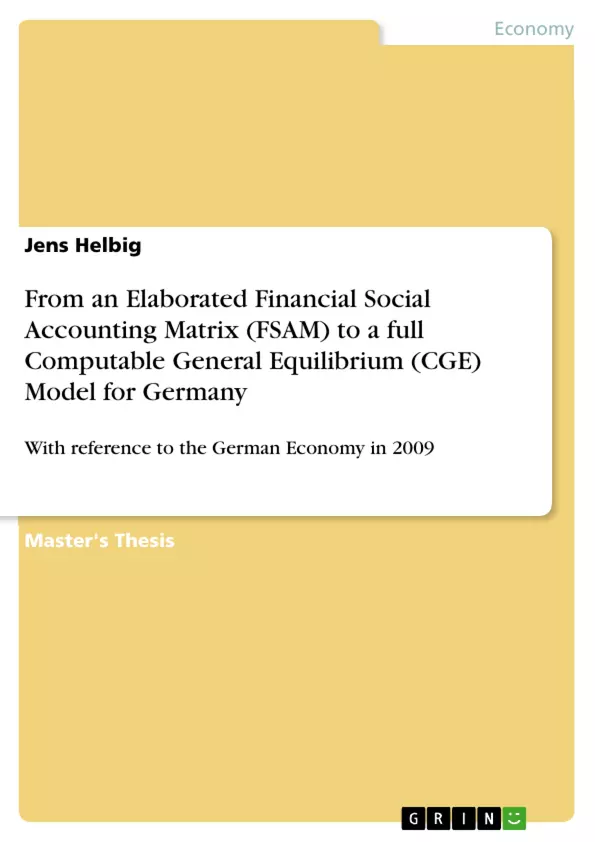In the light of recent economic crises the necessity of more detailed and especially financial investigations for economic policy makers and the majority of economic agents surged imperatively around the world. However, one quite popular analysis instrument used in many countries, unfortunately in Germany and some other members of the European Union seems to be lacking its deserved attention. Social Accounting Matrices (SAMs) and their respective Computable Equilibrium Models (CGEs) represent a useful tool for profound and targeted economic analysis worldwide.
Basically, observed and selected data of a base year is accommodated into a matrix presentation taking into account the double-entry accounting principle of revenues and expenditures revealing cross-institutional and cross-sectorial information or the mix of both. The underlying principle is to connect the producing part of an economy with the national institutions and the rest of the world in order to be able to conduct a significant analysis through a Computable Equilibrium Model. This model is calibrated and computed to generate the general equilibrium of an economy with the help of (mostly neo-classical) economic equations and assumptions reproducing the same values as observed in reality. In consequence, it is possible to perform an economic experiment predicting the reactions of the economy under consideration when facing those exogenous shocks.
Until now, most SAMs and therefore CGEs have focused on a too limited presentation of the economies ignoring completely the financial part of it, even though this is an essential and in modern economies decisive part of economic life. This paper aims to transmit a step by step illustration of the elaboration of a Financial Social Accounting Matrix (FSAM) and the gradual development of an economic CGE model written in GAMS which makes use of the same data. In the end, an experiment is conducted taking into account the German Share Index DAX and a multitude of macroeconomic equilibrium equations.
Inhaltsverzeichnis (Table of Contents)
- 1. Introduction
- 2. Building the FSAM
- 2.1 Classification
- 2.2 Goods & Services
- 2.3 Production
- 2.4 Income Generation
- 2.5 Allocation of Primary Income
- 2.6 Secondary Distribution of Income
- 2.7 Use of Disposable Income
- 2.8 Capital Account and Gross fixed Capital Formation
- 2.9 Financial Flows and Rest of the World
- 3. Working with Real Data and Assumptions
- 4. An Alternative FSAM Presentation
- 5. A Computable General Equilibrium Model Application
- 5.1 Statement of Problem
- 5.2 Macroeconomic Assumptions
- 5.2.1 Sectors' Behavior
- 5.2.2 Institutions' Behavior
- 5.2.3 Definition of Equilibrium
- 5.3 Model Calibration
- 5.4 Original Equilibrium
- 5.5 Economic Experiment and New Equilibrium
- 5.6 Comparison of Equilibria
- 6. Résumé and Conclusions
Zielsetzung und Themenschwerpunkte (Objectives and Key Themes)
This document serves as a guide to developing a Financial Social Accounting Matrix (FSAM) and a Computable General Equilibrium (CGE) model, using the German economy in 2009 as a reference point. The objective is to provide a comprehensive and practical framework for understanding and analyzing economic systems using these powerful modeling tools. The key themes explored in the text include:- The construction and application of a Financial Social Accounting Matrix (FSAM)
- The development and implementation of a Computable General Equilibrium (CGE) model
- The analysis of macroeconomic assumptions and their impact on economic equilibrium
- The use of real data and assumptions in economic modeling
- The comparison of different economic scenarios and their implications
Zusammenfassung der Kapitel (Chapter Summaries)
- Chapter 1 provides an introduction to the project, outlining its purpose, scope, and relevance.
- Chapter 2 delves into the construction of the FSAM, covering its classification, goods and services, production, income generation, allocation of primary income, secondary distribution of income, use of disposable income, capital account, and financial flows.
- Chapter 3 focuses on the practical aspects of working with real data and assumptions in the context of the FSAM.
- Chapter 4 presents an alternative approach to the FSAM, offering a different perspective on the data and its organization.
- Chapter 5 explores the application of a CGE model, outlining its statement of problem, macroeconomic assumptions, model calibration, original equilibrium, economic experiment, and comparison of equilibria.
Schlüsselwörter (Keywords)
The core concepts and focus areas of this work revolve around the fields of economic modeling, social accounting, and macroeconomic analysis. Key terms include Financial Social Accounting Matrix (FSAM), Computable General Equilibrium (CGE) model, economic equilibrium, macroeconomic assumptions, real data, and sectoral behavior. The project utilizes these tools and concepts to analyze the German economy in 2009, providing insights into its structure, dynamics, and potential for policy interventions.- Quote paper
- Jens Helbig (Author), 2013, From an Elaborated Financial Social Accounting Matrix (FSAM) to a full Computable General Equilibrium (CGE) Model for Germany, Munich, GRIN Verlag, https://www.grin.com/document/266314



